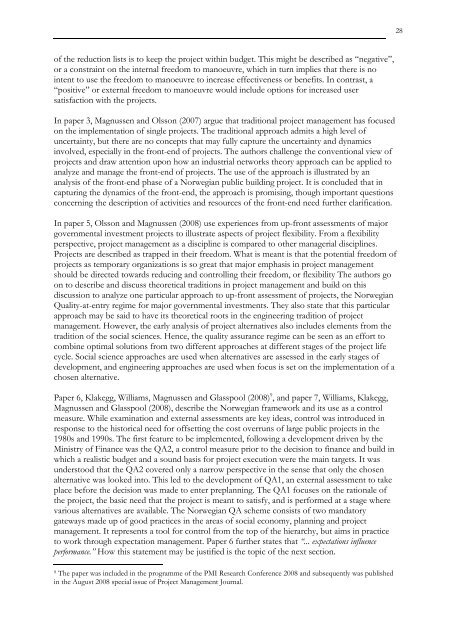Link to thesis. - Concept - NTNU
Link to thesis. - Concept - NTNU
Link to thesis. - Concept - NTNU
- No tags were found...
Create successful ePaper yourself
Turn your PDF publications into a flip-book with our unique Google optimized e-Paper software.
28of the reduction lists is <strong>to</strong> keep the project within budget. This might be described as “negative”,or a constraint on the internal freedom <strong>to</strong> manoeuvre, which in turn implies that there is nointent <strong>to</strong> use the freedom <strong>to</strong> manoeuvre <strong>to</strong> increase effectiveness or benefits. In contrast, a“positive” or external freedom <strong>to</strong> manoeuvre would include options for increased usersatisfaction with the projects.In paper 3, Magnussen and Olsson (2007) argue that traditional project management has focusedon the implementation of single projects. The traditional approach admits a high level ofuncertainty, but there are no concepts that may fully capture the uncertainty and dynamicsinvolved, especially in the front-end of projects. The authors challenge the conventional view ofprojects and draw attention upon how an industrial networks theory approach can be applied <strong>to</strong>analyze and manage the front-end of projects. The use of the approach is illustrated by ananalysis of the front-end phase of a Norwegian public building project. It is concluded that incapturing the dynamics of the front-end, the approach is promising, though important questionsconcerning the description of activities and resources of the front-end need further clarification.In paper 5, Olsson and Magnussen (2008) use experiences from up-front assessments of majorgovernmental investment projects <strong>to</strong> illustrate aspects of project flexibility. From a flexibilityperspective, project management as a discipline is compared <strong>to</strong> other managerial disciplines.Projects are described as trapped in their freedom. What is meant is that the potential freedom ofprojects as temporary organizations is so great that major emphasis in project managementshould be directed <strong>to</strong>wards reducing and controlling their freedom, or flexibility The authors goon <strong>to</strong> describe and discuss theoretical traditions in project management and build on thisdiscussion <strong>to</strong> analyze one particular approach <strong>to</strong> up-front assessment of projects, the NorwegianQuality-at-entry regime for major governmental investments. They also state that this particularapproach may be said <strong>to</strong> have its theoretical roots in the engineering tradition of projectmanagement. However, the early analysis of project alternatives also includes elements from thetradition of the social sciences. Hence, the quality assurance regime can be seen as an effort <strong>to</strong>combine optimal solutions from two different approaches at different stages of the project lifecycle. Social science approaches are used when alternatives are assessed in the early stages ofdevelopment, and engineering approaches are used when focus is set on the implementation of achosen alternative.Paper 6, Klakegg, Williams, Magnussen and Glasspool (2008) 9 , and paper 7, Williams, Klakegg,Magnussen and Glasspool (2008), describe the Norwegian framework and its use as a controlmeasure. While examination and external assessments are key ideas, control was introduced inresponse <strong>to</strong> the his<strong>to</strong>rical need for offsetting the cost overruns of large public projects in the1980s and 1990s. The first feature <strong>to</strong> be implemented, following a development driven by theMinistry of Finance was the QA2, a control measure prior <strong>to</strong> the decision <strong>to</strong> finance and build inwhich a realistic budget and a sound basis for project execution were the main targets. It wasunders<strong>to</strong>od that the QA2 covered only a narrow perspective in the sense that only the chosenalternative was looked in<strong>to</strong>. This led <strong>to</strong> the development of QA1, an external assessment <strong>to</strong> takeplace before the decision was made <strong>to</strong> enter preplanning. The QA1 focuses on the rationale ofthe project, the basic need that the project is meant <strong>to</strong> satisfy, and is performed at a stage wherevarious alternatives are available. The Norwegian QA scheme consists of two manda<strong>to</strong>rygateways made up of good practices in the areas of social economy, planning and projectmanagement. It represents a <strong>to</strong>ol for control from the <strong>to</strong>p of the hierarchy, but aims in practice<strong>to</strong> work through expectation management. Paper 6 further states that “... expectations influenceperformance.” How this statement may be justified is the <strong>to</strong>pic of the next section.9 The paper was included in the programme of the PMI Research Conference 2008 and subsequently was publishedin the August 2008 special issue of Project Management Journal.
















